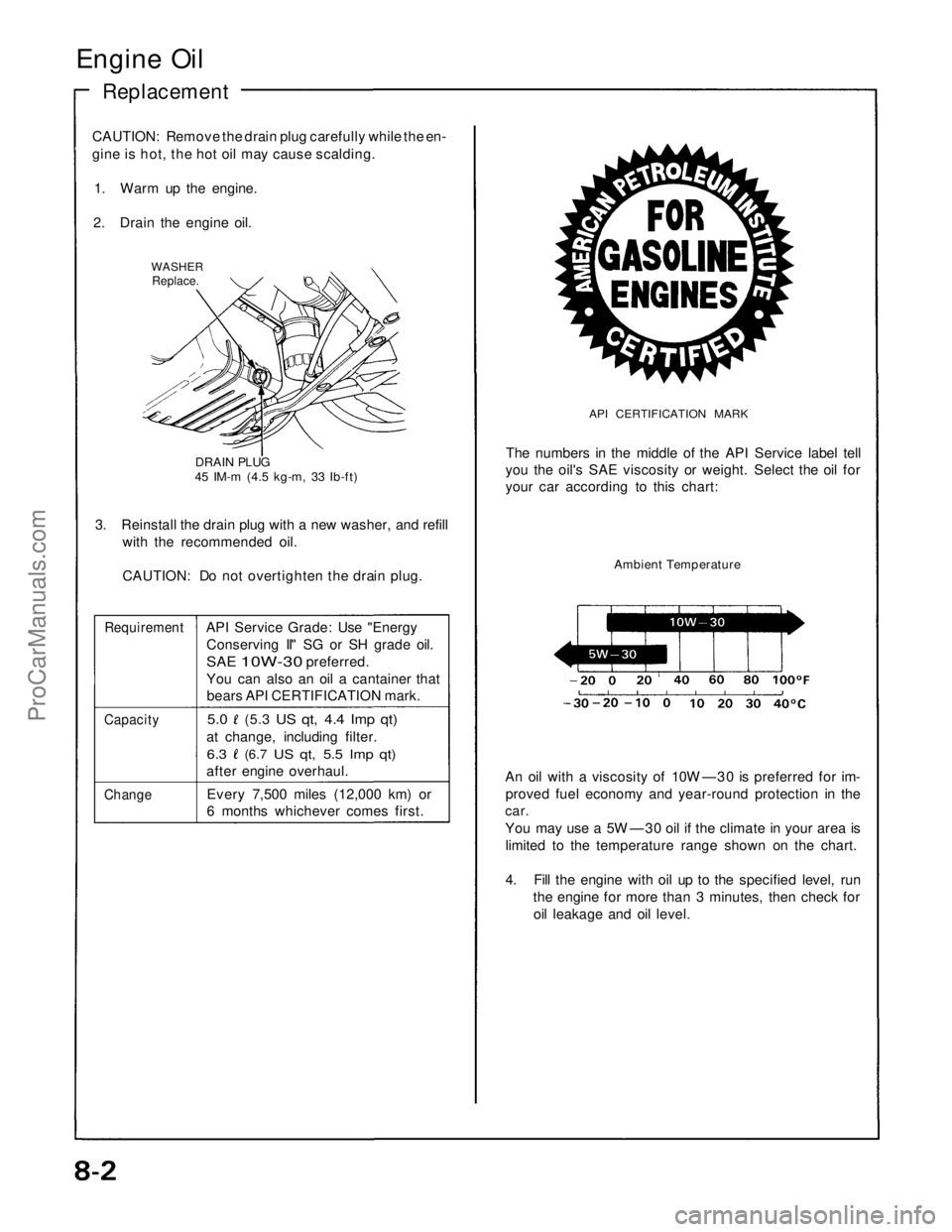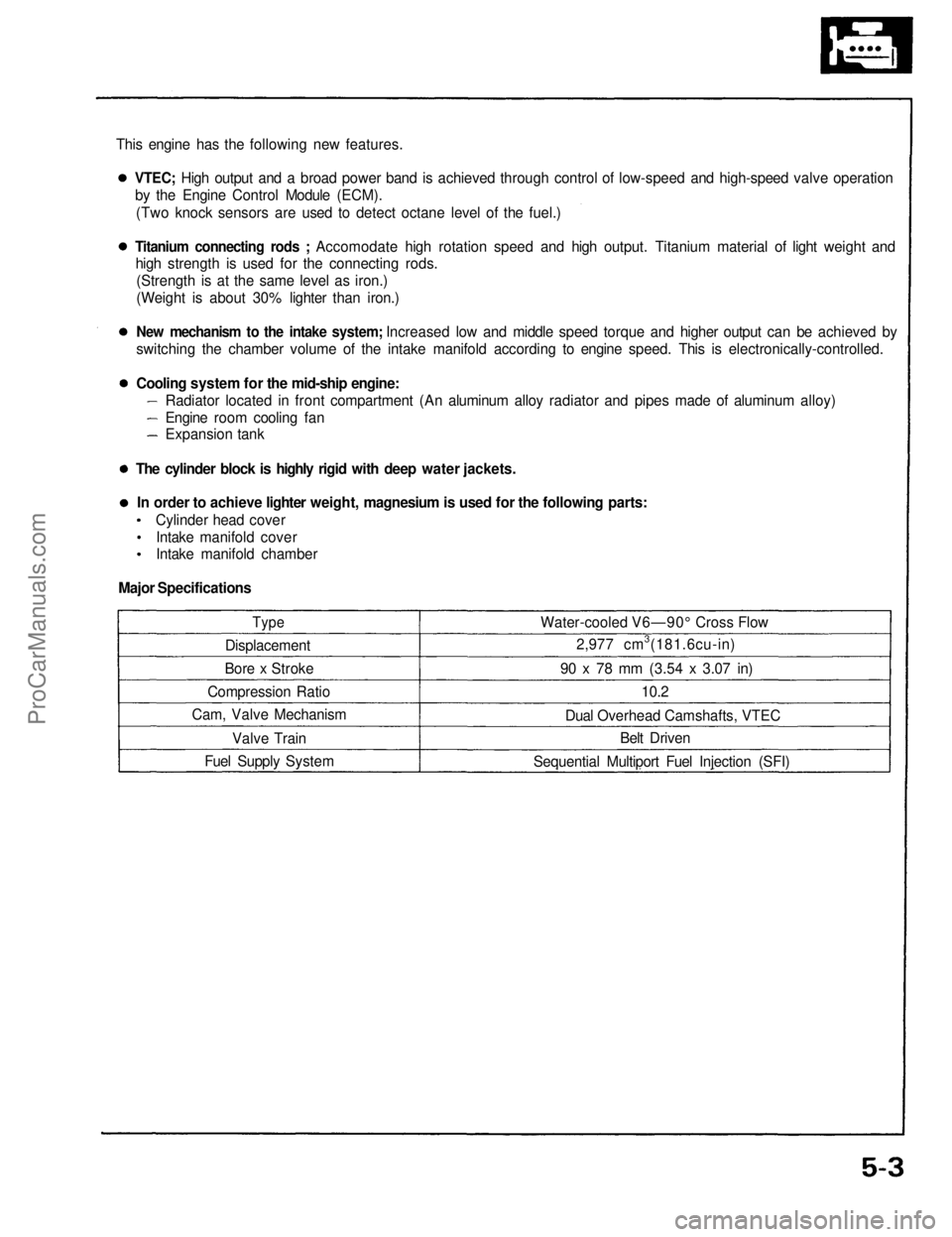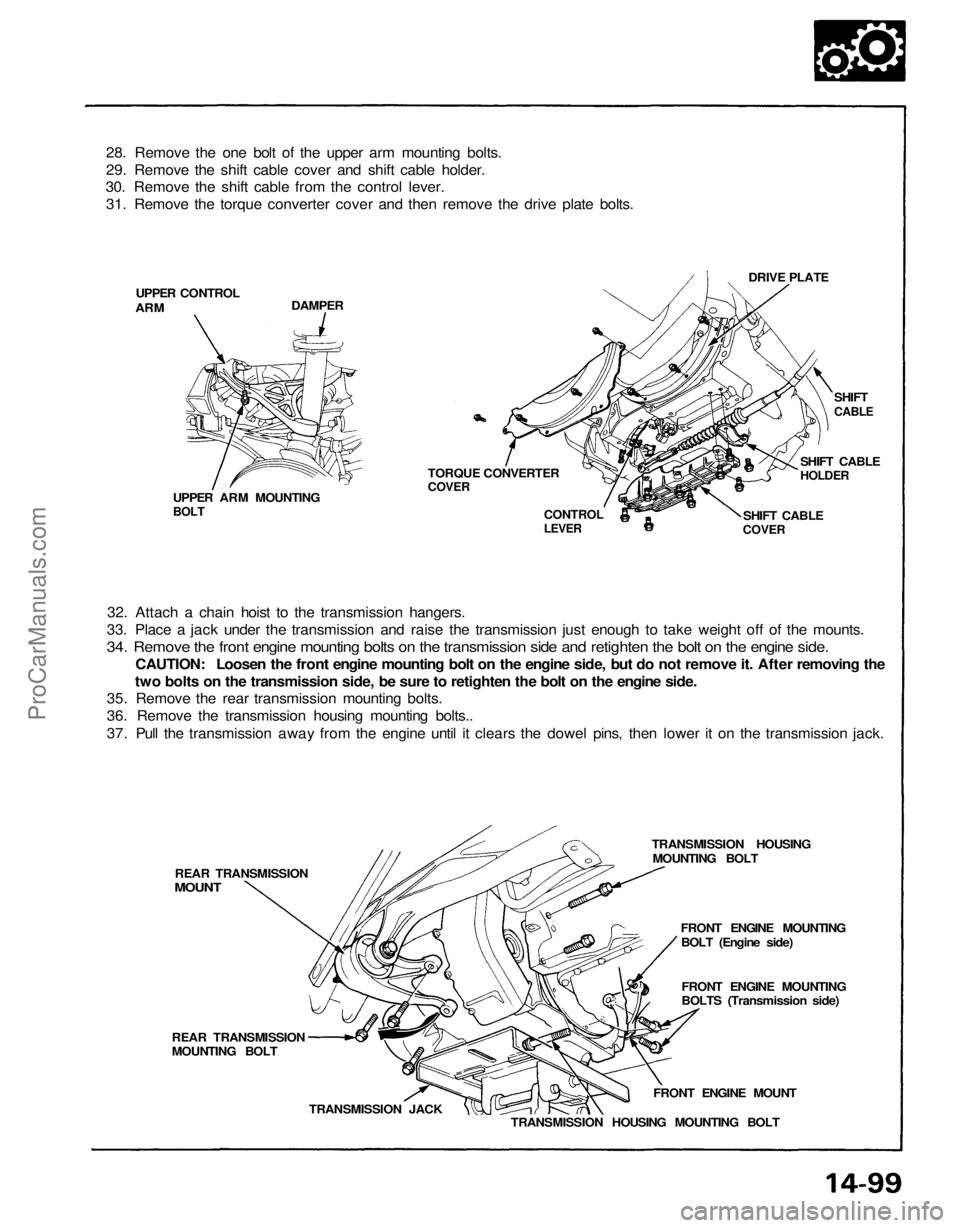Page 966 of 1640

Engine Oil
Replacement
CAUTION: Remove the drain plug carefully while the en-
gine is hot, the hot oil may cause scalding.
1. Warm up the engine.
2. Drain the engine oil.
WASHER
Replace.
DRAIN PLUG
45 IM-m (4.5 kg-m, 33 Ib-ft)
3. Reinstall the drain plug with a new washer, and refill
with the recommended oil.
CAUTION: Do not overtighten the drain plug.
Requirement
API Service Grade: Use "Energy
Conserving II" SG or SH grade oil.
SAE
10W-30
preferred.
You can also an oil a cantainer that
bears API CERTIFICATION mark.
Capacity
5.0
(5.3
US qt, 4.4 Imp qt)
at change, including filter.
6.3
(6.7
US qt, 5.5 Imp qt)
after engine overhaul.
Change
Every 7,500 miles (12,000 km) or
6 months whichever comes first.
API CERTIFICATION MARK
The numbers in the middle of the API Service label tell
you the oil's SAE viscosity or weight. Select the oil for
your car according to this chart:
Ambient Temperature
An oil with a viscosity of 10W —30 is preferred for im-
proved fuel economy and year-round protection in the
car.
You may use a 5W —30 oil if the climate in your area is
limited to the temperature range shown on the chart.
4. Fill the engine with oil up to the specified level, run
the engine for more than 3 minutes, then check for
oil leakage and oil level.ProCarManuals.com
Page 978 of 1640

This engine has the following new features.
Type
Displacement
Bore x Stroke
Compression Ratio
Cam, Valve Mechanism
Valve Train
Fuel Supply System Water-cooled V6—90° Cross Flow
2,977 cm3(181.6cu-in)
90 x 78 mm
(3.54
x
3.07
in)
10.2
Dual Overhead Camshafts, VTEC Belt Driven
Sequential Multiport Fuel Injection (SFI)VTEC; High output and a broad power band is achieved through control of low-speed and high-speed valve operation
by the Engine Control Module (ECM).
(Two knock sensors are used to detect octane level of the fuel.)
Titanium connecting rods ; Accomodate high rotation speed and high output. Titanium material of light weight and
high strength is used for the connecting rods.
(Strength is at the same level as iron.)
(Weight is about 30% lighter than iron.)
New mechanism to the intake system; Increased low and middle speed torque and higher output can be achieved by
switching the chamber volume of the intake manifold according to engine speed. This is electronically-controlled.
Cooling system for the mid-ship engine:
Radiator located in front compartment (An aluminum alloy radiator and pipes made of aluminum alloy)
Engine room cooling fan
Expansion tank
The cylinder block is highly rigid with deep water jackets. In order to achieve lighter weight, magnesium is used for the following parts: Cylinder head coverIntake manifold cover
Intake manifold chamber
Major SpecificationsProCarManuals.com
Page 1151 of 1640

27. Remove the one of the upper control arm mounting bolt.
28. Remove the lower cover, change wire bracket and upper cover.
29. Remove the shift cable and select cable.
30. Remove the slave cylinder from the transmission.
NOTE: Do not operate the clutch pedal once the slave
cylinder has been removed.
31. Remove the release fork from the clutch release hanger, then hang the release fork on the clutch housing.
UPPER CONTROL ARM
DAMPER
SLAVE CYLINDER
UPPER COVER
UPPER ARM MOUNTING
BOLT
32. Remove the clutch housing cover. 33. Attach a chain hoist to the transmission hangers.
34. Place a jack under the transmission and raise the transmission just enough to take weight off mounts.
35. Remove the front engine mounting bolts on the transmission side and retighten the bolt on the engine side.
CAUTION: Loosen the front engine mounting bolt on the engine side, but do not remove it. After removing the two
bolts on the transmission side, be sure to retighten the bolt on the engine side.
36. Remove the rear transmission mounting bolts and engine stiffener.
37. Remove the transmission housing mounting bolts.
38. Pull the transmission away from the engine until it clears the mainshaft, then lower it on the transmission jack.
REAR TRANSMISSION
MOUNT
REAR TRANSMISSIONMOUNTING BOLT
TRANSMISSION JACK TRANSMISSION HOUSINGMOUNTING BOLT
ENGINE STIFFENER
CLUTCH HOUSING
COVER
TRANSMISSION HOUSING
MOUNTING BOLTS
FRONT ENGINE MOUNTING
BOLT
(Engine side)
FRONT ENGINE MOUNTING
BOLT
(Transmission side)
RELEASE FORK
COTTER PIN
Replace.
SHIFT CABLE
CHANGE WIRE
BRACKET
SELECT CABLE
LOWER COVER
Corrosion resistant bolt/nut
Corrosion resistant bolt/nutProCarManuals.com
Page 1232 of 1640

28. Remove the one bolt of the upper arm mounting bolts.
29. Remove the shift cable cover and shift cable holder.
30. Remove the shift cable from the control lever.
31. Remove the torque converter cover and then remove the drive plate bolts.
DRIVE PLATE
DAMPER
UPPER CONTROL
ARM
SHIFT
CABLE
SHIFT CABLE
HOLDER
SHIFT CABLE
COVER
CONTROL
LEVER
TORQUE CONVERTER
COVER
UPPER ARM MOUNTING
BOLT
32. Attach a chain hoist to the transmission hangers.
33. Place a jack under the transmission and raise the transmission just enough to take weight off of the mounts.34. Remove the front engine mounting bolts on the transmission side and retighten the bolt on the engine side.
CAUTION: Loosen the front engine mounting bolt on the engine side, but do not remove it. After removing the
two bolts on the transmission side, be sure to retighten the bolt on the engine side.
35. Remove the rear transmission mounting bolts.
36. Remove the transmission housing mounting bolts..
37. Pull the transmission away from the engine until it clears the dowel pins, then lower it on the transmission jack.
TRANSMISSION HOUSINGMOUNTING BOLT
FRONT ENGINE MOUNTINGBOLT (Engine side)
FRONT ENGINE MOUNTING
BOLTS (Transmission side)
FRONT ENGINE MOUNT
TRANSMISSION HOUSING MOUNTING BOLT
TRANSMISSION JACK
REAR TRANSMISSION
MOUNTING BOLT REAR TRANSMISSION
MOUNTProCarManuals.com
Page 1242 of 1640

7. Remove the valve and thoroughly clean it and the valve
body with solvent. Dry all parts with compressed air,
then reassemble using ATF as a lubricant.
VALVE
BODY
VALVE
ATF-soaked
#600 abrasive
paper
Repair
NOTE: This repair is only necessary if one or more of
the valves in a valve body do not slide smoothly in their bores. You may use this procedure to free the valves in
the valve bodies.
1. Soak a sheet of #600 abrasive paper in ATF for about
30 minutes.
2. Carefully tap the valve body so the sticking valve drops out of its bore.
CAUTION: It may be necessary to use a small
screwdriver to pry the valve free. Be careful not to scratch the bore with the screwdriver.
3. Inspect the valve for any scuff marks. Use the ATF-
soaked #600 paper to polish off any burrs that are on
the valve, then wash the valve in solvent and dry it
with compressed air.
4. Roll up half a sheet of ATF-soaked paper and insert it in the valve bore of the sticking valve.
Twist the paper slightly, so that it unrolls and fits the
bore tightly, then polish the bore by twisting the paper
as you push it in and out.
CAUTION: The valve body is aluminum and doesn't
require much polishing to remove any burrs.
5. Remove the 600 paper and thoroughly wash the
entire valve body in solvent, then dry with compressed
air.
6. Coat the valve with ATF then drop it into its bore. It should drop to the bottom of the bore under its own
weight. If not, repeat step 4, then retest.ProCarManuals.com
Page 1324 of 1640
System Description
Electrical Power Steering (EPS)
Outline
The NSX uses an electric motor-driven power steering, which possesses the characteristics best suited for a mid engine
automobile. This system is a power-assisted steering device, with a motor inside the steering gearbox driven by the EPS
control unit and power unit. Its distinctive features are described below:
ALTERNATOR
VEHICLE
SPEED SENSOR
STEERING WHEEL
EPS CONTROL UNIT
POWER UNIT
BATTERY
STEERING GEARBOX
STEERING
COLUMN
Minimized loss of engine horsepower and decreased fuel consumption.
A linear steering feel and the reduction of kickback.
The system is compact and lightweight because it requires no complicated hydraulic piping, etc.ProCarManuals.com
Page 1351 of 1640

Hub Replacement
NOTE: Use only genuine Honda wheel weights for aluminum wheels. Non-genuine wheel weights may corrode and damage
the aluminum wheels. Remove the center cap by prying it out with a flat screwdriver. Use a rag at the point you are going to pry, because
aluminum alloy wheels can be easily damaged. Avoid damage to the cap by not allowing it to fall during removal.
Before installing the brake disc, clean the mating surface of the front hub and inside of the brake disc.
Before installing the wheel, clean the mating surfaces of the brake disc and inside of the wheel.
Corrosion resistant bolt/nut.
SELF-LOCKING NUT
10 x
1.25
mm
Replace.
65 N .
m (6.5 kg-m, 47 Ib-ft)
SPLASH GUARD
KNUCKLE
SPINDLE NUT
26 x 1.5 mm
Replace.
335 N .
m (33.5 kg, 242 Ib-ft)
NOTE: After tightening,use a drift to
stake the spindle nut shoulder against
the spindle.
PULSER
HUB BEARING
ASSEMBLY
Inspect for faulty
movement and wear.
Replacement page 18-17 FRONT HUB
Check for damage or
cracks.
Replacement,
page 18-17.
BRAKE DISC
Check for wear or rust.
Inspection, section 19.
FLAT HEAD SCREW
6 x 1.0 mm
10 N .
m (1.0 kg-m, 7 Ib-ft) WHEEL NUT
12 x 1.5 mm
110 N .
m (11 kg-m, 80 Ib-ft)
CENTER CAPProCarManuals.com
Page 1356 of 1640

Hub Replacement
NOTE:
Use only genuine Honda wheel weights for aluminum wheels. Non-genuine wheel weights may corrode and damage
the aluminum wheels. Remove the center cap by prying it out with a flat screwdriver. Use a rag at the point you are going to pry, because
aluminum alloy wheels can be easily damaged. Avoid damage to the cap by not allowing it to fall during removal.
Before installing the brake disc, clean the mating surface of the rear hub and inside of the brake disc.Before installing the wheel, clean the mating surfaces of the brake disc and inside of the wheel.
FLANGE BOLT
10 x
1.25
mm
65 N .
m
(6.5 kg-m,
47 Ib-ft)
HUB BEARING
ASSEMBLY
Inspect for faulty
movement and wear.
Replacement, page 18-33
KNUCKLE
SPLASH GUARD
WHEEL NUT
12 x 1.5 mm
110 N .
m (11
kg-m,
80 Ib-ft)
BRAKE DISC
Check for wear or
rust.
Inspection,
Section 19.
REAR HUB UNIT
Check for damage or
cracks.
Replacement, page 18-33.
FLAT HEAD SCREW
6 x 1.0 mm
10 N .
m
(1.0 kg-m,
7 Ib-ft)
Corrosion resistant bolt/nutProCarManuals.com